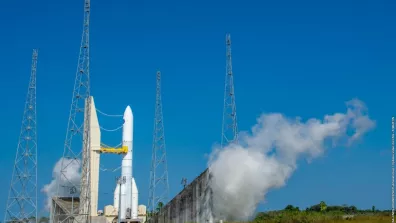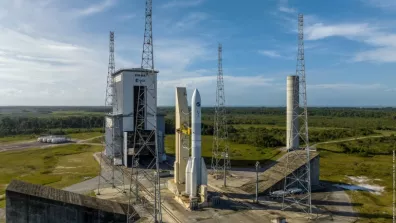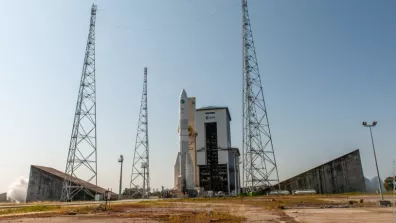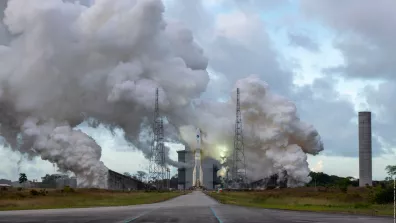The Ariane 6 Launcher Task Force consists of top management at ESA, the overall Ariane 6 procuring entity and launch system architect, launch base prime contractor and French space agency CNES, launcher system prime contractor ArianeGroup and launch service provider Arianespace. This group reports regularly on progress being made towards inaugural flight of the new Ariane 6 launcher.
Key milestones towards inaugural flight
1 September 2023: Upper stage hot firing test, Lampoldshausen, Germany
The data from the test at German aerospace agency DLR’s test centre is now analysed and shows excellent results. The test of the stage included more than 11 minutes (680 seconds) of operation of the Vinci re-ignitable engine in two boosts, including two boosts of the Auxiliary Power Unit (APU) in parallel with the operation of the Vinci engine. Analysis showed a very good operation of the two engines at the same time – which plays an essential role in the versatility and restarting capability of the Ariane 6 upper stage.
5 September 2023: Combined tests, hot firing test of the main stage with Vulcain 2.1, Kourou, French Guiana
A Wet Dress Rehearsal with the combined test launcher’s specimen installed on the Ariane 6 launch pad in Kourou, French Guiana, was successfully completed. The Vulcain 2.1 engine was ignited and fired for four seconds before being shut down by the on-board software as planned.
This test made it possible to validate the sequence of checks carried out before the solid booster ignition and a liftoff of Ariane 6.
This test was a major milestone in the combined tests campaign. It contributes to qualification of the launch sequence operations and engine ignition on the launch pad, and to qualification of the launcher. The test demonstrated the excellent maturity of the operational organisation and means.
Next milestones
Combined tests, long-duration hot firing of the main stage with Vulcain 2.1 engine, Kourou, French Guiana
Similar to the previous one, this test will end with about eight minutes (470 seconds) of firing of the Vulcain 2.1 engine, representing the entire flight phase of the core stage.
During a normal procedure in preparation of the stage for the test, an anomaly was detected affecting the hydraulic group of the thrust vector control system. The role of the thrust vector control is to maintain the launcher's attitude by gimballing the Vulcain 2.1 engine during flight. Further investigations are necessary before running this long-duration hot firing test, which can no longer take place on 3 October. The task force will provide an update when the conclusions of the investigation are known.
As per standing plan, the Ariane 6 inaugural flight launch period estimate will only be given when the combined long firing test will have been carried out and the test results analysed.
End-2023: Upper stage hot firing test, Lampoldshausen, Germany
Further hot-firing test of the upper stage is planned to examine stage behaviour in degraded cases.
Ariane 6 is an all-new design, created to succeed Ariane 5 as Europe's heavy-lift launch system. With Ariane 6's upper stage restart capability, Europe's launch capability will be tailored to the needs of multiple payload missions, for example to orbit satellite constellations. This autonomous capability to reach Earth orbit and deep space supports Europe's navigation, Earth observation, scientific and security programmes. Ongoing development of Europe's space transportation capabilities is made possible by the sustained dedication of thousands of talented people working in ESA's 22 Member States.





